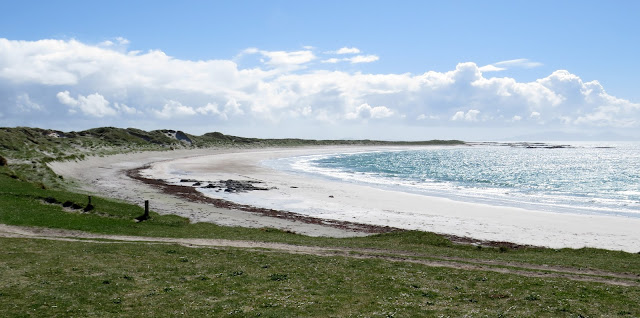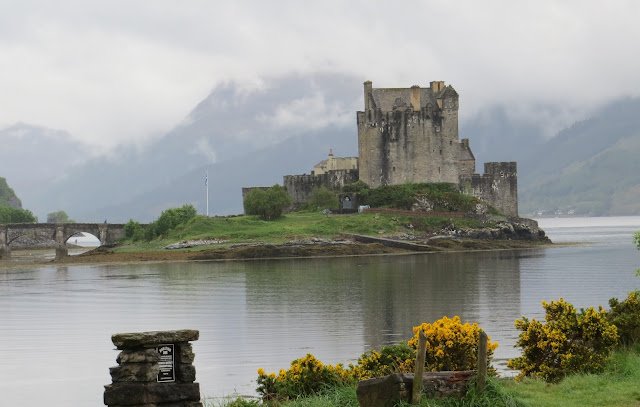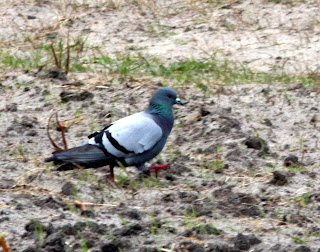Does a Head Count?
Saturday May 6
Still no small waders at the camp site, usually Dunlin and Ringed Plovers whizz about restlessly. Three Atlantic Grey Seals jostled for space to sprawl, on a small lichen covered rock.
A few Great Northern Divers at the mouth of the bay, Sand Martins flying about and a small group of Linnets where we often find Twite. We loved our hour or so here before driving back to Bunessan and towards Pennyghael. The tide was inexorably coming in, I've never seen so much water in Loch Beg. Where does Beg end and Loch Scridain begin? We enjoyed an ice-cream at the bridge beyond the shop before skirting the shores of Loch Scridain, as slowly as was possible, looking for Otters. We did find clumps of Butterwort, a few in flower, in the usual place, the hoofprints of cattle disturbing the mud beside the trickle of roadside water.
An insectivorous plant, the bright yellow-green leaves of Common Butterwort excrete a sticky fluid which attracts unsuspecting insects. Once an insect get trapped, the leaves slowly curl around their prey and digest it. The acidic bogs, fens and damp heaths that Common Butterwort lives in don't provide it with enough nutrients, so it has evolved this carnivorous way of life to supplement its diet. Common Butterwort has purple flowers that appear from May to July, giving the plant its other common names of 'Bog Violet' and 'Marsh Violet'
I know of a White-tailed Eagle nest which is viewable from the road - if you know where to look. Convenient lay-bys are labelled with large yellow 'Do not park nor stop' signs. I think that this highlights the nest's location rather than acting as a deterrent. We turned round and stopped in the middle of the road, undisturbed by traffic, whilst we watched the white head of the sitting adult appear above the nest rim from time to time. Can you see it?
Opening the bedroom curtains this morning I was pleasantly surprised to find.......sun. Still. The best run of weather we've ever had in this lovely country. It was cooler until the afternoon, more wind would account for that.
Still no John, Jane is doing everything, cooking and serving breakfast. We have always had a 7.30 breakfast here, until this year. We're tired after a hectic week in the Highlands and a lot of travelling. It's always interesting to find out who's sharing the breakfast table.To-day we had a lady from the state of Maine who visits every year, off to spend her usual three weeks on Iona from to-day. A lot of religious Americans stay here.
As always, Fidden was the first call, driving as far as Knockvollogen where one has to turn round. One of the fields included this magnificent ram, whose horns had been truncated before they pierced his cheeks.
Twenty Whimbrel still in the nearer sheep fields plus, many Hooded Crows keeping a silent undertaker's vigil, hoping for a weak lamb. One Whinchat, Wheatears, Linnets, Buzzard, Whitethroat and a Stonechat.
Twenty Whimbrel still in the nearer sheep fields plus, many Hooded Crows keeping a silent undertaker's vigil, hoping for a weak lamb. One Whinchat, Wheatears, Linnets, Buzzard, Whitethroat and a Stonechat.
Still no small waders at the camp site, usually Dunlin and Ringed Plovers whizz about restlessly. Three Atlantic Grey Seals jostled for space to sprawl, on a small lichen covered rock.
For a sunny Saturday, Uisken near Bunessan was surprisingly quiet. The narrow track passes ruined dwellings, evidence of the Clearances, through sedge-tussocked moorland to the small bay. Not much parking space but it's possible to drive a fair way across the back of the bay to what is known as the Croft camping ground. We stopped on a grassy mound with a picnic table, about half way across. Again, none of the usual small waders amongst the rocks and seaweed where fresh water runs in.
I want one of these.
A few Great Northern Divers at the mouth of the bay, Sand Martins flying about and a small group of Linnets where we often find Twite. We loved our hour or so here before driving back to Bunessan and towards Pennyghael. The tide was inexorably coming in, I've never seen so much water in Loch Beg. Where does Beg end and Loch Scridain begin? We enjoyed an ice-cream at the bridge beyond the shop before skirting the shores of Loch Scridain, as slowly as was possible, looking for Otters. We did find clumps of Butterwort, a few in flower, in the usual place, the hoofprints of cattle disturbing the mud beside the trickle of roadside water.
An insectivorous plant, the bright yellow-green leaves of Common Butterwort excrete a sticky fluid which attracts unsuspecting insects. Once an insect get trapped, the leaves slowly curl around their prey and digest it. The acidic bogs, fens and damp heaths that Common Butterwort lives in don't provide it with enough nutrients, so it has evolved this carnivorous way of life to supplement its diet. Common Butterwort has purple flowers that appear from May to July, giving the plant its other common names of 'Bog Violet' and 'Marsh Violet'
The egg(s) can't have hatched yet or the other adult would be bringing food in and posing nearby. Brian and his tour group had been there some time.
Time to make our way back to Seaview. Driving on rough single track roads, constantly having to dive into lay-bys to allow other vehicles to pass, is very tiring. Our last day in the area to-morrow, Loch na Keal maybe.








Comments
Post a Comment